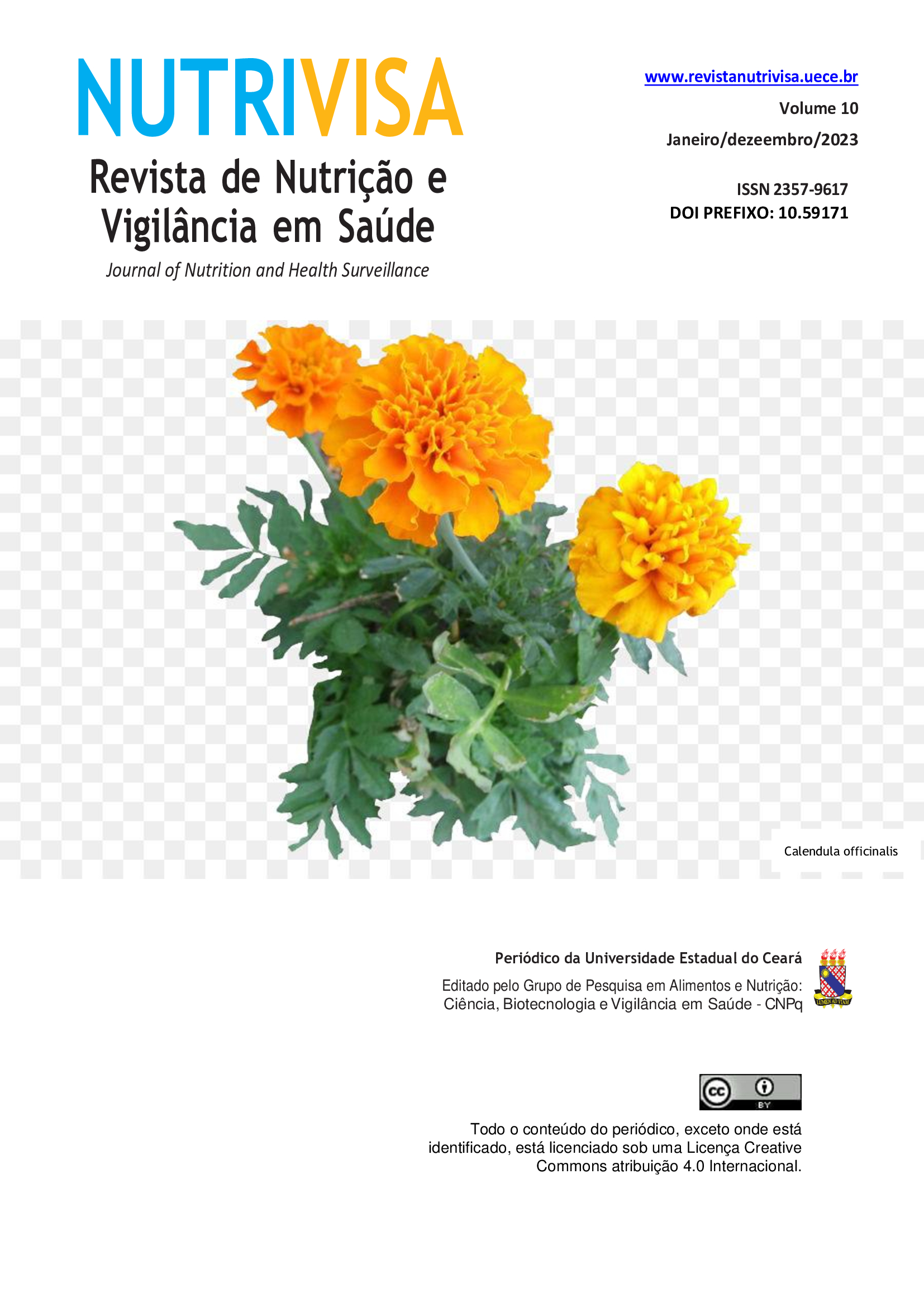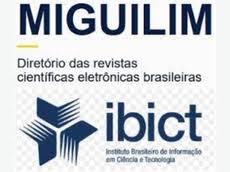A presença de métodos pedagógicos nas ações de educação alimentar e nutricional para crianças e adolescentes no Brasil e exterior
DOI:
https://doi.org/10.59171/nutrivisa-2023v10e10511Palavras-chave:
Educação alimentar e nutricional, ensino fundamental e médio, escolasResumo
Objetivou-se verificar, por meio de uma revisão integrativa de literatura, se as publicações sobre as intervenções em Educação Alimentar e Nutricional (EAN), realizadas no ensino fundamental e médio, para crianças e adolescentes no Brasil e exterior, estão sendo executadas com o uso de algum método pedagógico pré-definido. A EAN quando aplicada com métodos educacionais adequados, pode favorecer o diálogo entre o educador e o educando e os resultados podem ser satisfatórios. Utilizou-se para a coleta de dados as bases de dados Literatura Latino-Americana e do Caribe em Ciências da Saúde (LILACS); Biblioteca Virtual de Saúde (BVS); US National Library of Medicine (PUBMED); Portal de Periódicos da Coordenação de Aperfeiçoamento de Pessoal de Nível Superior (CAPES); e Scientific Electronic Library Online (SciELO). Após a aplicação dos critérios de inclusão e exclusão, obteve-se uma amostra de 35 publicações. Percebeu-se que poucas ações de EAN utilizaram um método pedagógico. Os resultados demonstraram que os pesquisadores precisam ancorar as suas ações de EAN a métodos pedagógicos, de forma mais clara, pois podem proporcionar a ampliação do conhecimento sobre alimentação adequada e saudável, aumentar a autonomia nas escolhas alimentares, e a efetividade das intervenções em alimentação e nutrição.
Referências
AL-JAWALDEH, A.; TAKTOUK, M.; NASREDDINE, L.. Food Consumption Patterns and Nutrient Intakes of Children and Adolescents in the Eastern Mediterranean Region: A Call for Policy Action. Nutrients, v.12, n.11, p.1-28, 2020.
ANDERSON, A.S.; PORTEOUS, L.E.G.; FOSTER, E.; HIGGINS, C.; STEAD, M.; HETHERINGTON, M.; HA, M-A.; ADAMSON, A.J. The impact of a school-based nutrition education intervention on dietary intake and cognitive and attitudinal variables relating to fruits and vegetables. Public Health Nutr., v.8, n.6, p.650-6, 2005.
ARLINGHAUS, K.R.; MORENO, J.P.; REESOR, L.; HERNANDEZ, D.C.; JOHNSTON, C.A.. Compañeros: High School Students Mentor Middle School Students to Address Obesity Among Hispanic Adolescents. Prev Chronic Dis.,v. 14, p.E92, 2017.
ASHFIELD-WATT, P.A.; STEWART, E.A.; SCHEFFER, J.A. A pilot study of the effect of providing daily free fruit to primary-school children in Auckland, New Zealand. Public Health Nutr., v.12, n.5, p.693-701, 2009.
BANDURA, A. Social foundations of thought and action: a social cognitive
theory. Englewood Cliffs, NJ: Prentice Hall; 1986.
BLITSTEIN, J.L.; CATES, S.C.; HERSEY, J.; MONTGOMERY, D.; SHELLEY, M.; HRADEK, C.; KOSA, K.; BELL, L.; LONG, V.; WILLIAMS, P.A.; OLSON, S.; SINGH,A.. Adding a Social Marketing Campaign to a School-Based Nutrition Education Program Improves Children's Dietary Intake: A Quasi-Experimental Study. J Acad Nutr Diet,v.116, n. 8, p.1285-94, 2016.
BOOG, M.C.F. Educação em Nutrição: integrando experiências. 1ª edição. Campinas: Komedi, 2013, 268 p.
BORSOI, A.T.; TEO, C.R.P.A.; MUSSIO, B.R. Educação alimentar e nutricional no ambiente escolar: uma revisão integrativa. Revista Ibero-Americana de Estudos em Educação, v. 11, n. 3, p. 1441–1460, 2016.
BRASIL. Ministério da Saúde. Portaria Interministerial nº 1010, de 08 de maio de 2006. Institui as diretrizes para a Promoção da Alimentação Saudável nas Escolas de educação infantil, fundamental e nível médio das redes públicas e privadas, em âmbito nacional. 2006.
______. Ministério da Saúde. Secretaria de Atenção à Saúde. Departamento de Atenção Básica. Passo a passo PSE: Programa Saúde na Escola: tecendo caminhos da intersetorialidade . Ministério da Saúde. Secretaria de Atenção à Saúde. Departamento de Atenção Básica, Ministério da Educação. Brasília : Ministério da Saúde, 2011, 46p.
______. Ministério do Desenvolvimento Social e Combate à Fome.Secretaria Nacional de Segurança Alimentar e Nutricional. Marco de referência de educação alimentar e nutricional para as políticas públicas. Brasília, DF: MDS, 2012, 68p.
______. Ministério da Saúde. Secretaria de Atenção à Saúde. Departamento de Atenção Básica. Política Nacional de Alimentação e Nutrição. Ministério da Saúde, Secretaria de Atenção à Saúde. Departamento de Atenção Básica.Básica. – 1. ed., 1. reimpr. – Brasília : Ministério da Saúde, 2013, 84p.
______. Resolução nº 510, de 07 de abril de 2016. Dispõe sobre as normas aplicáveis a pesquisas em Ciências Humanas e Sociais. Diário Oficial da República Federativa do Brasil, Brasília, DF, 2016.
_______. Lei nº 13.666 de 16 de março de 2018. Altera a Lei nº 9.394, de 20 de dezembro de 1996, para incluir o tema transversal da educação alimentar e nutricional no currículo escolar, 2018.
BRAUN, V.; CLARKE, V. Using thematic analysis in psychology. Qualitative Research in Psychology, v.3, n.2, p. 77-101, 2006.
BRONFENBRENNER, U. Ecological systems theory. Annals of Child Development ,v. 6, p.187-249, 1989.
CAMOSSA, A.C.A; COSTA, F.N.A.; OLIVEIRA, P.F.; FIGUEIREDO, T.P. Educação nutricional: uma área em desenvolvimento. Alimentação e Nutrição, v. 16, p. 349-54, 2005.
CARRIL, M.G.P.; NATÁRIO, E.G.; ZOCCAL, S.I. Considerações sobre aprendizagem significativa, a partir da visão de Freire e Ausubel – uma reflexão teórica. e-Mosaicos - Revista Multidisciplinar de Ensino, Pesquisa, Extensão e Cultura do Instituto de Aplicação Fernando Rodrigues da Silveira, v.6, n.13, 2017, p.68-78.
CERVATO-MANCUSO, A.; VINCHA, K.; SANTIAGO, D. Educação Alimentar e Nutricional como prática de intervenção: reflexão e possibilidades de fortalecimento. Physis: Revista de Saúde Coletiva, v. 26, n.1, p. 225-249, 2016.
CHAGAS, C.M.S.; SILVA, T.B.P.; REFFATTI, L.M.; BOTELHO, R.B.A.; TORAL, N. Rango Cards, a digital game designed to promote a healthy diet: a randomized study protocol. BMC Public Health, v. 18, n.1, p.910-919, 2018.
DAVIS, J.D.; PÉREZ, A.; ASIGBEE, F.M.; LANDRY, M.J.; VANDYOUSEFI, S.; GHADDAR, E.; HOOVER, A.; JEANS. M.; NIKAH, K.; FISCHER, B.; PONT, S.J.; RICHARDS, D.; HOELSCHER, D.M.; BERG, A.E.V.D. School-based gardening, cooking and nutrition intervention increased vegetable intake but did not reduce BMI: Texas sprouts - a cluster randomized controlled trial. Int J Behav Nutr Phys Act. , v.18, n.1, p.18, 2021.
DECOSTA, P.; MØLLER, P.; FRØST, M.B.; OLSEN, A. Changing children’s eating behaviour - A review of experimental research. Appetite, v.113, p.327-57, 2017.
EISENMANN, J.C; ALAIMO, K.; PFEIFFER, K.; PAEK, H-J.; CARLSON, J.J.; HAYES, H.; THOMPSON, T.; KELLEHER, D.; OH, H.J.; ORTH, J.; RANDALL, S.; MAYFIELD, K.; HOLMES, D. Project FIT: rationale, design and baseline characteristics of a school- and community-based intervention to address physical activity and healthy eating among low-income elementary school children. BMC Public Health, v. 11, p.607, 2011.
FREIRE, P. Pedagogia do oprimido.42ª edição. Rio de Janeiro, Paz e Terra, 2005, 107 p.
IULIANO, B.A.; MANCUSO, A.N.C.; GAMBARDELLA, A.M.D. Educação nutricional em escolas de ensino fundamental do município de Guarulhos-SP. O Mundo da Saúde, v.33, n. 3, p. 264–272, 2009.
KATZ, D.D.; TREU, J.A.; AYETTEY, R.G.; KAVSAK, Y.; KATZ, C. S.; NJIKE, V. Testing the effectiveness of an abbreviated version of the Nutrition Detectives program. Prev Chronic Dis. , v.11, p.E57, 2014.
MAGALHÃES, Q.V.B.; CAVALCANTE, J.L.P. Educação alimentar e nutricional como intervenção em hábitos alimentares saudáveis no ambiente escolar. SANARE - Revista De Políticas Públicas, v. 18, n. 8, p.59-67, 2019.
MARQUES, C.L. Metodologia do lúdico na prática docente para a melhoria da aprendizagem na educação inclusiva. Revista Eixo, v. 1, n. 2, p. 80-91, 2012.
MELO, G.R.A.; VARGAS, F.C.S.; CHAGAS, C.M.S.; TORAL, N. Nutritional interventions for adolescents using information and communication technologies (ICTs): A systematic review. PLoS One, v. 12, n.9, p.e0184509, 2017.
MENDES, K.D.S.; SILVEIRA, R.C.C.P.; GALVÃO, C.M. Revisão integrativa: método de pesquisa para a incorporação de evidências na saúde e na enfermagem. Texto Contexto Enferm., v. 17, n. 4, p.758-764, 2008.
MOREIRA, M.A. Aprendizagem significativa. Brasília: UnB, 1999.
NITTARI, G.; SCURI, S.; PETRELLI, F.; PIRILLO, I.; DI LUCA, N.M.; GRAPPASONNI, I. Fighting obesity in children from European World Health Organization member states. Epidemiological data, medical-social aspects, and prevention programs. Clin. Ter. , v.170, n.3, p. e223-e230, 2019.
PELEGRINI, A.; BIM, M.A.; SOUZA, F.U; KILIM, K.S.S.; PINTO, A.A. Prevalência de sobrepeso e obesidade em crianças e adolescentes brasileiros: uma revisão sistemática. Revista Bras. Cineantropom. Desempenho Humano, v.23, p. 1-19,2021.
PROCHASKA, J.O.; REDDING, C.A.; EVERS, K.E. The Transtheoretical Model and stages of change. In: Glanz K, Lewis FM, Rimer BK. editors. Health Behavior and Health Education: Theory, Research, and Practice 2nd ed. California: JosseyBass; 1996.
ROSSI, C.E.; NORONHA, L.A.; TONELLO, P.L. Ações de educação alimentar e nutricional para adolescentes de realeza-PR: relato de um projeto integrado de ensino de graduação. R. Eletr. de Extensão , v. 18, n. 40, p. 199-214, 2021.
SANTOS, A.C.V.; KLEIN, T.A.S. Educação Nutricional no Ensino Fundamental: Implementação de Atividades Baseadas na Teoria da Aprendizagem Significativa. Cadernos PDE [versão online], v. 1, p. 1-18, 2016. Disponível em: http://www.diaadiaeducacao.pr.gov.br/portals/cadernospde/pdebusca/producoes_pde/2016/2016_artigo_cien_uel_anaclaudialeoncio.pdf. Acesso em: jun.2021.
SANTOS, L.A.S. O fazer educação alimentar e nutricional: algumas contribuições para reflexão. Ciência & Saúde Coletiva, v. 17, n. 2, p. 453-46, 2012.
SCARPARO, A.L.S; RAMOS, M. Proposta metodológica para o planejamento de Programa de Educação Alimentar e Nutricional de acordo com os pressupostos do Método Paulo Freire, p.34-44, 2021. In: ALVES, G.S.B.; OLIVEIRA, E.; GONÇALVES, M.C.S.; JESUS, B.G., Educação Contemporânea, v.30, p.1-157, 2021.
SGAMBATO, M.R.; CUNHA, D.B.; HENRIQUES, V.T.; ESTIMA, C.C.P.; SOUZA, B.S.N.; PEREIRA, R.A.; YOKOO, E.M.; PARAVIDINO, V.B.; SICHIERI, R. PAAPPAS community trial protocol: a randomized study of obesity prevention for adolescents combining school with household intervention. BMC Public Health, v 16 , n.1 , p.809, 2016.
SHARMA, N.; SRIVASTAV, A.K.; SAMUEL, A.J. Ensaio clínico randomizado: padrão ouro de desenhos experimentais - importância, vantagens, desvantagens e preconceitos. Rev. Pesqui. Fisioter , v. 10, n.3, p. 512-519, 2020.
SHEN,Y-H; LIU, Z.; LI, W-H.; ZHOU, S.; XU, J-H.; JIANG, C.; WANG, H-J. The Smartphone-Assisted Intervention Improved Perception of Nutritional Status among Middle School Students. Int J Environ Res Public Health, v. 17, n.16, p.5932, 2020.
SORDI, M.R.L.; BAGNATO, M.H.S. Subsídios para uma formação profissional crítico-reflexiva na área da saúde: o desafio da virada do século. Rev. Latino-Am. Enfermagem, v. 6, n.2, p.83-88, 1998.
SOUZA M.T.; SILVA M.D.; CARVALHO, R. Revisão integrativa: o que é e como fazer. Einstein, v.8, n.1, p.102-106, 2010.
STETLER, C.B.; BRUNELL, M.; GIULIANO, K.K.; MORSI, M.; PRINCE, L.; NEWELL-STOKES, V. Evidence-based practice and the role of nursing leadership. J Nurs Adm. v.28, n.7-8, p.45-53, 1998.
VASCONCELOS, M.L.M.C.; BRITO, R.H.P. Conceitos de educação em Paulo Freire. 6. ed. São Paulo: Vozes, 2014.
ZANCUL, M.D.S.; DUTRA-DE- OLIVEIRA, J.E. Considerações sobre ações de educação alimentar e nutricional para adolescentes. Alimentos e Nutrição, v. 18, n. 2, p. 223–227, 2007.
Downloads
Publicado
Como Citar
Edição
Seção
Licença
Copyright (c) 2023 Isabel Cristina Bento, Luciana Neri Nobre

Este trabalho está licenciado sob uma licença Creative Commons Attribution 4.0 International License.














